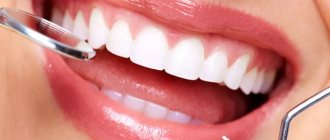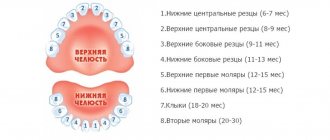20.11.2019
The eruption of baby teeth in a child is a gradual process, and it takes approximately 2-3 years until all 20 baby teeth erupt. Initially, when the first baby teeth erupt, children, as a rule, experience difficulties of various kinds. So, at the age of 3-9 months, children may increase salivation, they begin to bite and gnaw at everything, and they may experience shooting pain in the ears.
In this case, parents may assume that the child is actively teething. In addition, during this period children become extremely irritable and whiny. If you experience shooting pains in the ear, it is important to make sure that they are not associated with an infectious ear disease, since many of the symptoms of teething and ear infections are similar. While teething is a natural process and there are many ways to help your baby get through this difficult time, ear infections (ear infections) require special medical evaluation and treatment.
What to do if teeth do not erupt “on time”?
Nothing to do. As stated earlier, the timing is quite relative and not strict data. There is such a thing as the individual characteristics of a child. Plus neonatal indicators, physical constitution, etc. Thus, the timing of the appearance of teeth in your child is normal for him. The same applies to permanent teeth.
The later the teeth appear, the healthier they will be?
Is not a fact. The timing of teething does not affect their “quality”.
What sedatives can be used during teething? Do they influence the process itself?
No, such drugs do not affect the process of teeth formation and, as a rule, have no side effects. For children with allergies, there is a sedative called Doctor Baby that does not contain lidocaine. Almost all gels contain lidocaine and inert fillers (cooling menthol, astringents and flavoring additives). You can use Dentinox, Kalgel (be careful with diathesis, because it is sweet), Kamistad (very effective, but you need to know when to stop), Mundizal, Cholisal, Solcoseryl dental paste (especially good in the presence of wounds or ulcers).
How often should such drugs be used?
Soothing gels are not antibiotics and do not need to be used according to a specific regimen. If the child is in pain, apply it, but if everything is calm, don’t. But it’s better not to use it more than 3-4 times a day and for longer than 3 days in a row.
Preventive measures
Units with a hollow, even in the absence of discomfort, are a source of infection. Caries can cause ENT problems. Therefore, do not put off visiting the dentist if your tooth hurts and radiates into your ear. To prevent pathology:
- You need to visit the dentist regularly. This minimizes the risks of developing oral diseases. The dentist will identify the problem at its inception and correct it in a timely manner.
- You should carefully care for the oral cavity, clean the chewing organs twice a day, use floss, irrigator, and rinses.
- Timely treatment of viral and infectious diseases is necessary. Untreated flu often causes otitis media.
- It is necessary to prevent inflammation of the nerves by strengthening the body's defenses.
- You should eat a balanced diet and lead a healthy lifestyle.
The lack of preventive measures and treatment of diseases leads to serious complications.
Is it possible to speed up teething?
Medication - no. But massaging your gums won't hurt at all. Using a clean finger, gently and gently massage your baby's gums. The baby will feel better, and the tooth will cut through faster. Just do not press hard so as not to injure the gums. You can give your child a cool spoon or pacifier to hold in his mouth. Try buying special teethers with liquid. They are placed in the refrigerator for a while, and then given to the child to chew on. All these methods are good in moderation, do not overdo it.
Can bad breath occur during teething and what is the cause?
The process of teething is associated with partial decomposition (lysis) of the mucous membrane under the action of salivary enzymes. We all notice that the amount of saliva increases sharply during this period. In this case, indeed, indicators such as viscosity, color and smell of saliva may change. Another factor is the presence of weak antibacterial substances in saliva, which are designed to prevent infection of the wound when a tooth cuts through the gum. A certain amount of blood also enters the oral cavity. When it decomposes, a sour (metallic) odor may appear.
A sharp increase in temperature during teething. What to do?
Teething does not cause a temperature jump to 39-40 degrees. Only a slight increase is possible, which is normal. Be careful: teething should not cause high fever, diarrhea, vomiting, complete loss of appetite, cramps or choking. If you have such symptoms, even if you attribute it to your teeth, consult a doctor. It is also not recommended to use antipyretics and painkillers without consulting him.
What is the difference between an increase in temperature due to teething and an increase due to other reasons? How long can the elevated temperature last in the first case?
It all depends on the individual characteristics of the child. Basically, hyperthermia and diarrhea are only secondary signs of the teething process, which in itself is a serious physiological turning point for a small organism. Fever is, rather, a reaction to inflammation of the oral mucosa. After all, at the site where the tooth exits, irritation forms, often a wound that can become infected. Thus, hyperthermia is caused not by the mechanism of tooth formation itself, but by side effects. After all, the eruption of permanent teeth, despite the similarity of histological and physiological changes, causes symptoms of colds and diarrhea extremely rarely. And it is quite simple to explain their appearance in children: changes in diet and diet, constant foreign objects in the mouth, microflora disturbance, weakened immunity in the nasopharynx. So, if high fever and loose stools continue for more than 72 hours, then teething really has nothing to do with it.
Child fiddling with ears
24.11.2020
At times, as a result of long-term observation, new parents notice increased attention from the baby to the ear . The child picks at his ears , so much so that he can involuntarily scratch the skin with his nails, trying to remove the cap he is wearing. The best scenario in this case is that a lint is discovered by the parents, which accidentally came from a cotton swab and creates anxiety for the newborn. However, in most cases, the occurrence of such a phenomenon is based on quite serious violations.
Causes of the phenomenon
In order to allay parents' concerns, it is indispensable to master some theoretical aspects regarding the reasons why a child touches his ears . At a minimum, such knowledge will allow them to achieve calm in the absence of compelling reasons for groundless panic, and at maximum, it will guarantee the ability to independently eliminate the underlying factors that caused the formation of such an unpleasant phenomenon. By following instructions for overcoming discomfort, parents will be able to neutralize the sensation of itching, which can affect the quality of children's sleep.
Among the main reasons why a child picks his ears are:
- the presence of fungus in the area of the external auditory canal;
- the presence of an allergic reaction to a certain external or internal irritant (as a result, the child touches the ears , and may also focus on the eyes and nose ; there is a possibility of a runny nose for no apparent reason);
- the appearance of purulent phenomena followed by discharge from the ear canal (in the presence of otitis media );
- desire to explore one’s own body and body parts;
- manifestation of a natural desire to go to sleep or get the necessary food;
- the presence of skin diseases;
- lack of sufficient level of personal hygiene;
- the likelihood of teething (especially important for 6-8 months of age);
- the result of bites of various insects.
In the case of continuous mechanical impact from the child on the ear , increased attention should be paid to determine the reason for the appearance of such interest. The ability to identify an irritating factor and its subsequent elimination guarantees the disappearance of the child’s anxiety. Despite the existence of home options for resolving this situation, one should not forget about the importance of obtaining qualified advice from the attending physician regarding the child’s health condition and recommendations regarding the necessary treatment and prophylactic complex.
Treatment methods
Among the existing options for treating discomfort in a child are:
- systematically carry out hygienic procedures of the ear canal (it is necessary to pay attention to the absence of villi after the procedure);
- neutralize possible contacts with allergenic factors (plants at the time of flowering, dust, animals);
- create a well-functioning daily routine (due to the occurrence of skin diseases as a result of disruptions in the children's nervous system );
- take a vitamin course for a nursing mother;
- eliminate possible acts of prescribing medications for infants (to do this, you need to visit your doctor );
- periodically bathe the child in a bath with the addition of anti-inflammatory herbs (chamomile, string, oak bark).
If there are no visible results after carrying out the measures described above, it is strongly recommended to visit a specialist in order to receive recommendations regarding the implementation of treatment and preventive measures.
Published in Otorhinolaryngology Premium Clinic
Teething in infants
Possible characteristics of teeth in children at the teething stage. Stay up to date.
The expansion of the spaces between the teeth is caused by the growth of the jaws. During the transition from baby teeth to permanent teeth, it is considered a normal condition. A wide gap between the upper anterior incisors is usually associated with a deep-lying maxillary frenulum. An orthodontist should observe and treat such a gap between the teeth;
- a blackish edging on the neck of the tooth can form when taking soluble iron supplements, as well as during a chronic inflammatory process (precipitation of bacteria from the leptotrichium group);
- yellowish-brown staining of teeth may be associated with the use of antibiotics - by the mother in the 2nd half of pregnancy or by the child himself during the formation of teeth;
- yellowish-greenish coloring is caused by severe disturbances in bilirubin metabolism, hemolytic conditions (destruction of red blood cells);
- reddish staining of tooth enamel is characteristic of a disease called porphyria - a congenital disorder of the metabolism of porphyrin pigment;
- malocclusions are formed by the uneven growth of the child’s jaws, as well as prolonged sucking of the nipples;
- Anomalies in the location of teeth occur for a number of reasons: trauma, congenital disorders of connective tissue metabolism, constitutional reasons (small jaw size), tumors of the alveolar process of the jaw.
- the absence of teeth before one year of age is extremely rarely associated with edentia (lack of tooth buds), which can be checked using radiovisiography as prescribed by a pediatric dentist.
If teeth erupt on time and in a certain order, this indicates the normal development of the child’s body. After all, this physiological process is in direct connection with the general health of the baby. Some atypical cases may indirectly indicate the presence of pathology. But only a special examination of the child can confirm or refute the assumptions made. The reasons must be identified and analyzed by a specialist.
Finding the cause – who to contact?
Pathologies of the molars often lead to pain in the ears and jaw, and the pain radiates to the temple. To avoid serious complications, you should consult a general practitioner in time. If necessary, he will refer the patient to a dentist, neurologist, ENT specialist, or endocrinologist. If your visit to the doctor is delayed, you can take a pain reliever. But this measure is temporary. When eights grow, some patients even have trouble hearing. This situation is especially typical with the growth of third molars in the upper jaw. For diagnosis, visiography is done. Based on its results, the patient is referred to a dentist or otolaryngologist.
Pain in the area of the auditory organs causes pulpitis. In this case, the dentist must eliminate the inflammatory process that occurs in the nerve fibers. You cannot self-medicate so as not to aggravate the situation and lose one unit. For successful therapy, the root cause of the pathology must be removed. Before going to the dental office, you can rinse your mouth with a solution of chlorhexidine, infusions of sage, oak bark, and chamomile. Warming compresses should not be used to prevent flux from forming and spreading the infection.











